Demonetization Crisis in Asia: Impact, Strategies, and Communication
VerifiedAdded on 2023/06/11
|9
|2030
|119
Report
AI Summary
This report addresses the impact of demonetization on businesses in Asia, targeting CEOs and corporate functional leaders outside the region. It acknowledges their limited prior knowledge of demonetization while recognizing their awareness of other Asian crises. The primary purpose is to raise awareness about the adverse effects of demonetization on business operations, employee productivity, and overall demand. The report highlights the cash crunch caused by demonetization, especially affecting small businesses and sectors reliant on cash transactions. It recommends actions such as promoting digital literacy, utilizing e-wallets, and improving access to mobile ATMs. It further emphasizes the need for businesses to maintain accurate financial records and explore alternative funding sources. By implementing these strategies, organizations can mitigate the negative impacts of demonetization and sustain business performance. Desklib offers similar solved assignments for students.
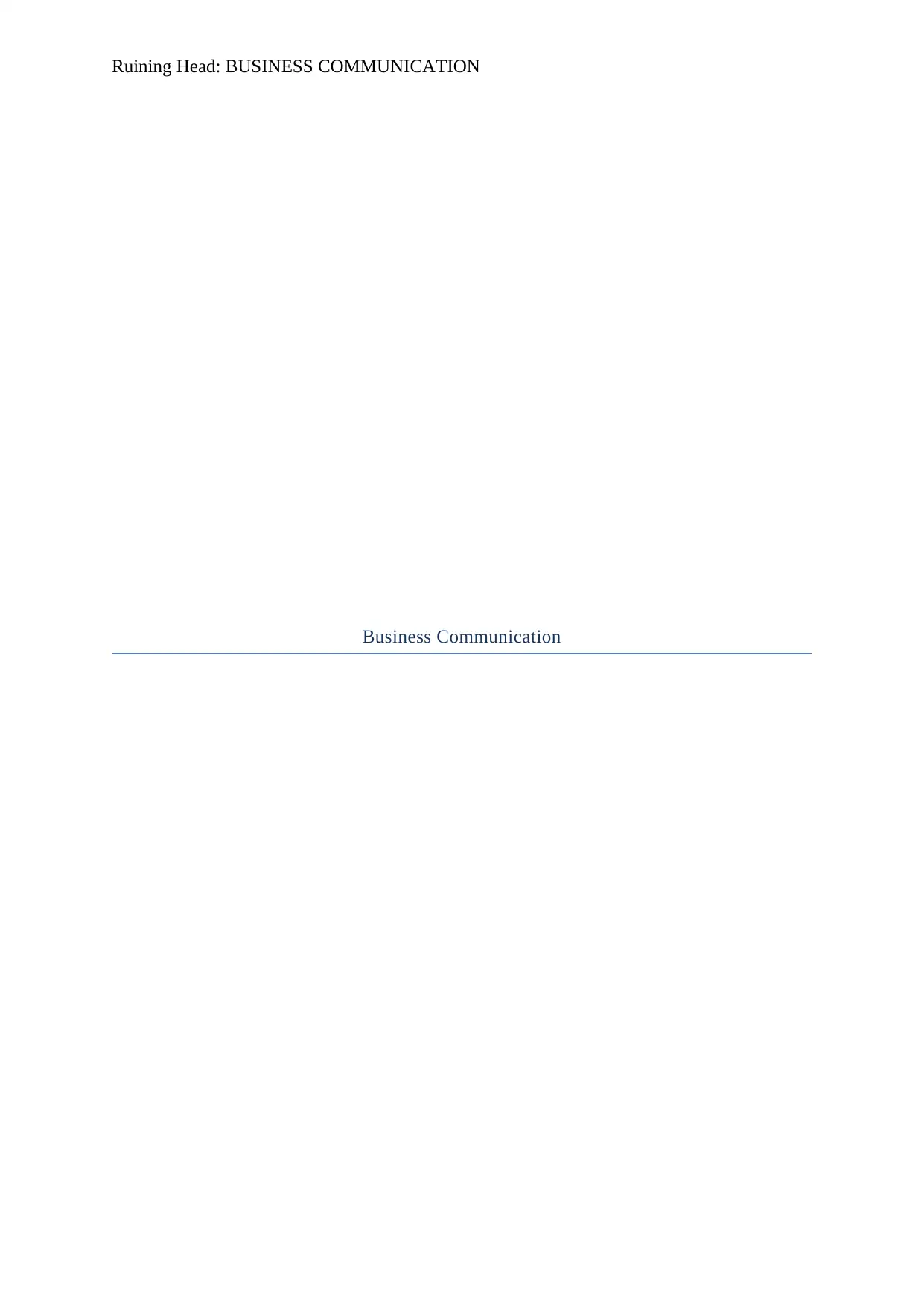
Ruining Head: BUSINESS COMMUNICATION
Business Communication
Business Communication
Paraphrase This Document
Need a fresh take? Get an instant paraphrase of this document with our AI Paraphraser
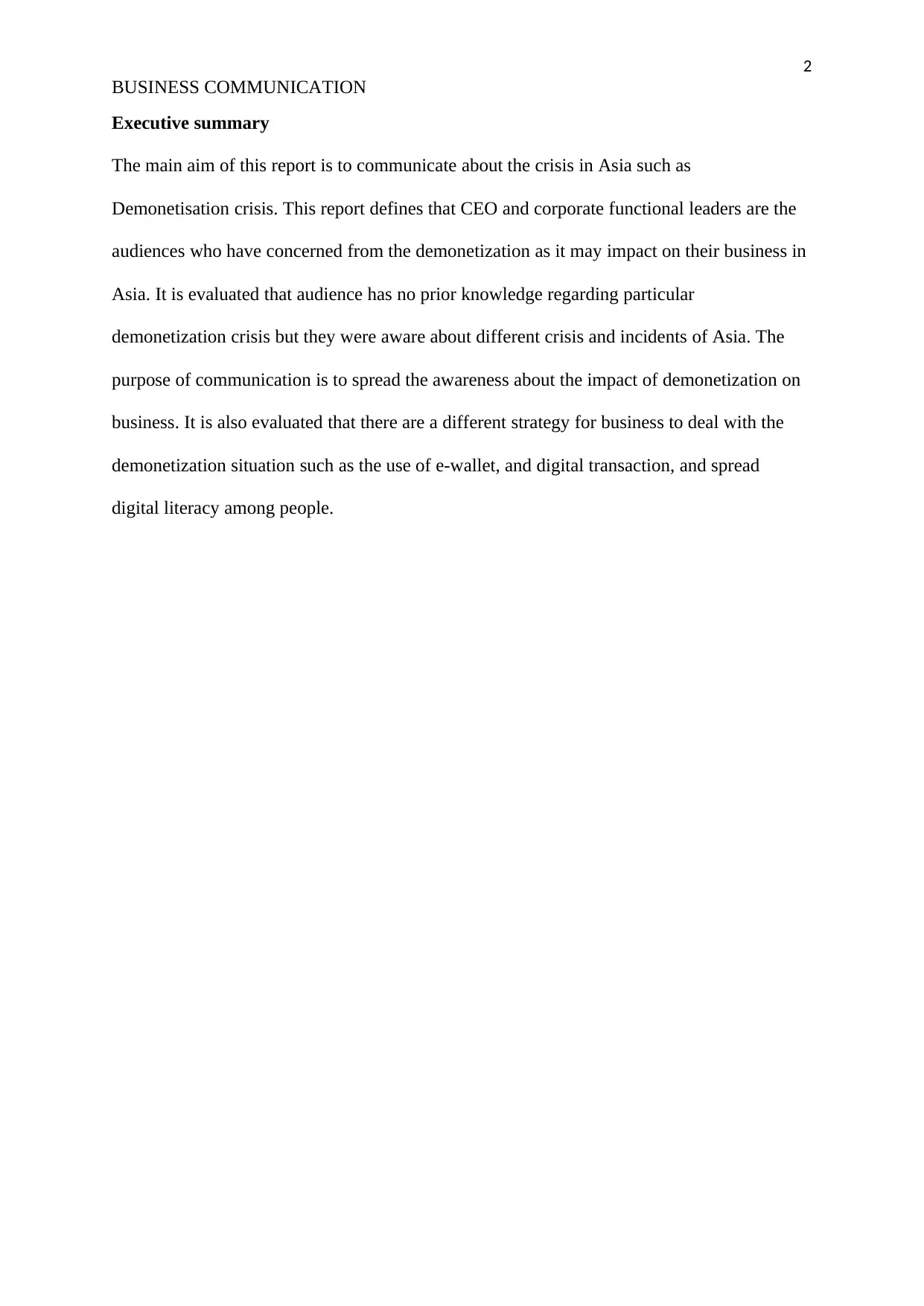
2
BUSINESS COMMUNICATION
Executive summary
The main aim of this report is to communicate about the crisis in Asia such as
Demonetisation crisis. This report defines that CEO and corporate functional leaders are the
audiences who have concerned from the demonetization as it may impact on their business in
Asia. It is evaluated that audience has no prior knowledge regarding particular
demonetization crisis but they were aware about different crisis and incidents of Asia. The
purpose of communication is to spread the awareness about the impact of demonetization on
business. It is also evaluated that there are a different strategy for business to deal with the
demonetization situation such as the use of e-wallet, and digital transaction, and spread
digital literacy among people.
BUSINESS COMMUNICATION
Executive summary
The main aim of this report is to communicate about the crisis in Asia such as
Demonetisation crisis. This report defines that CEO and corporate functional leaders are the
audiences who have concerned from the demonetization as it may impact on their business in
Asia. It is evaluated that audience has no prior knowledge regarding particular
demonetization crisis but they were aware about different crisis and incidents of Asia. The
purpose of communication is to spread the awareness about the impact of demonetization on
business. It is also evaluated that there are a different strategy for business to deal with the
demonetization situation such as the use of e-wallet, and digital transaction, and spread
digital literacy among people.
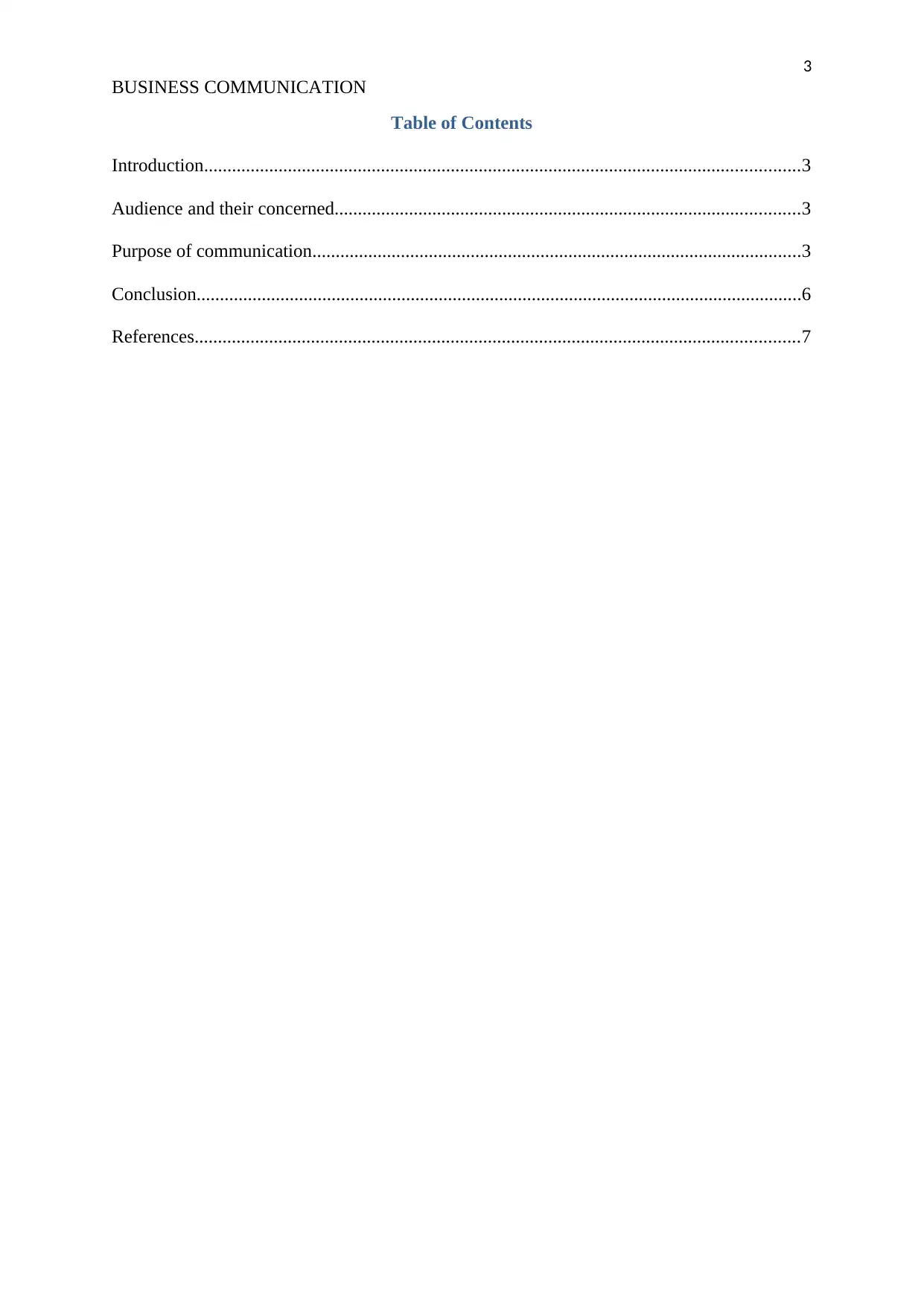
3
BUSINESS COMMUNICATION
Table of Contents
Introduction................................................................................................................................3
Audience and their concerned....................................................................................................3
Purpose of communication.........................................................................................................3
Conclusion..................................................................................................................................6
References..................................................................................................................................7
BUSINESS COMMUNICATION
Table of Contents
Introduction................................................................................................................................3
Audience and their concerned....................................................................................................3
Purpose of communication.........................................................................................................3
Conclusion..................................................................................................................................6
References..................................................................................................................................7
⊘ This is a preview!⊘
Do you want full access?
Subscribe today to unlock all pages.

Trusted by 1+ million students worldwide
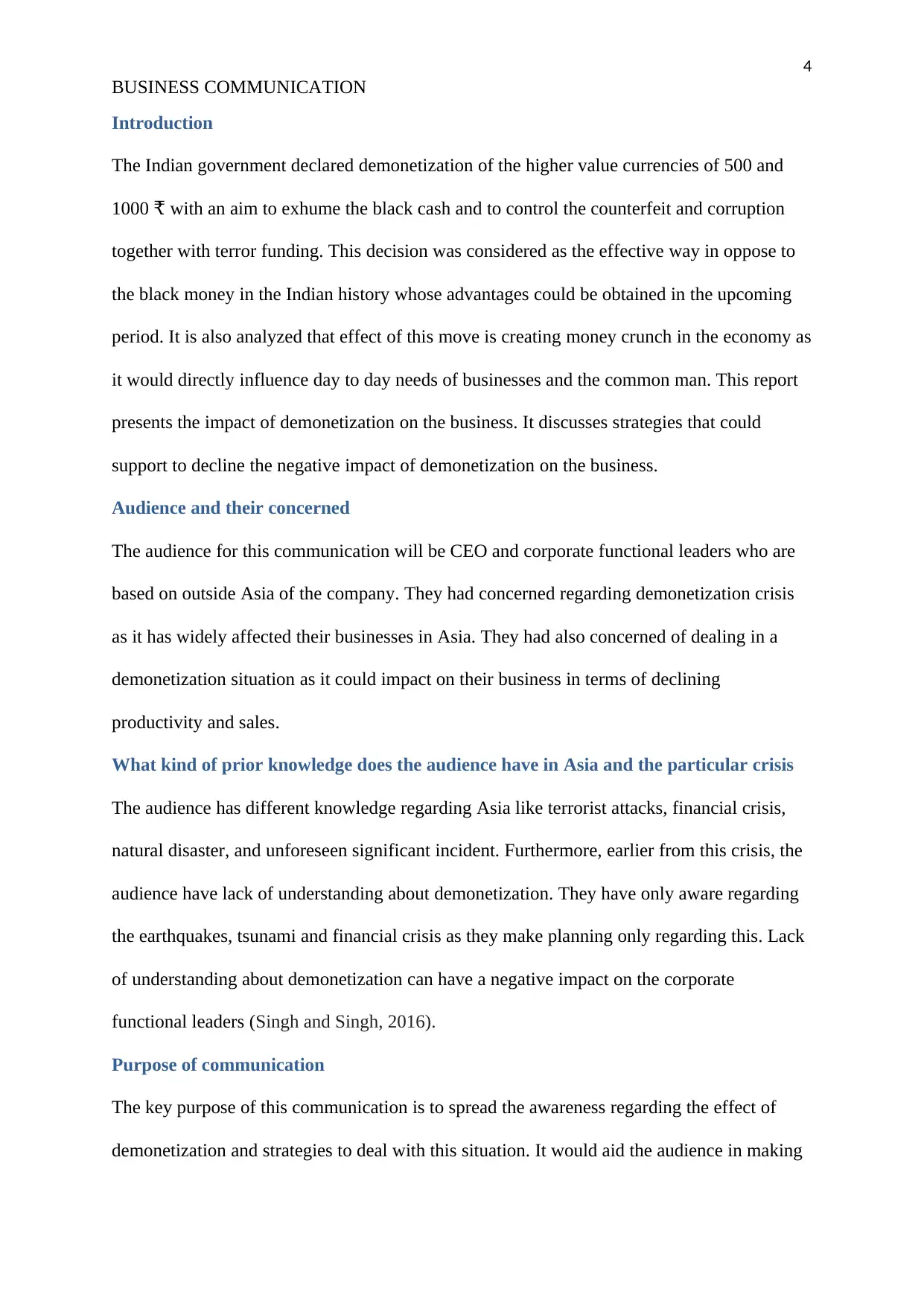
4
BUSINESS COMMUNICATION
Introduction
The Indian government declared demonetization of the higher value currencies of 500 and
1000 with an aim to exhume the black cash and to control the counterfeit and corruption₹
together with terror funding. This decision was considered as the effective way in oppose to
the black money in the Indian history whose advantages could be obtained in the upcoming
period. It is also analyzed that effect of this move is creating money crunch in the economy as
it would directly influence day to day needs of businesses and the common man. This report
presents the impact of demonetization on the business. It discusses strategies that could
support to decline the negative impact of demonetization on the business.
Audience and their concerned
The audience for this communication will be CEO and corporate functional leaders who are
based on outside Asia of the company. They had concerned regarding demonetization crisis
as it has widely affected their businesses in Asia. They had also concerned of dealing in a
demonetization situation as it could impact on their business in terms of declining
productivity and sales.
What kind of prior knowledge does the audience have in Asia and the particular crisis
The audience has different knowledge regarding Asia like terrorist attacks, financial crisis,
natural disaster, and unforeseen significant incident. Furthermore, earlier from this crisis, the
audience have lack of understanding about demonetization. They have only aware regarding
the earthquakes, tsunami and financial crisis as they make planning only regarding this. Lack
of understanding about demonetization can have a negative impact on the corporate
functional leaders (Singh and Singh, 2016).
Purpose of communication
The key purpose of this communication is to spread the awareness regarding the effect of
demonetization and strategies to deal with this situation. It would aid the audience in making
BUSINESS COMMUNICATION
Introduction
The Indian government declared demonetization of the higher value currencies of 500 and
1000 with an aim to exhume the black cash and to control the counterfeit and corruption₹
together with terror funding. This decision was considered as the effective way in oppose to
the black money in the Indian history whose advantages could be obtained in the upcoming
period. It is also analyzed that effect of this move is creating money crunch in the economy as
it would directly influence day to day needs of businesses and the common man. This report
presents the impact of demonetization on the business. It discusses strategies that could
support to decline the negative impact of demonetization on the business.
Audience and their concerned
The audience for this communication will be CEO and corporate functional leaders who are
based on outside Asia of the company. They had concerned regarding demonetization crisis
as it has widely affected their businesses in Asia. They had also concerned of dealing in a
demonetization situation as it could impact on their business in terms of declining
productivity and sales.
What kind of prior knowledge does the audience have in Asia and the particular crisis
The audience has different knowledge regarding Asia like terrorist attacks, financial crisis,
natural disaster, and unforeseen significant incident. Furthermore, earlier from this crisis, the
audience have lack of understanding about demonetization. They have only aware regarding
the earthquakes, tsunami and financial crisis as they make planning only regarding this. Lack
of understanding about demonetization can have a negative impact on the corporate
functional leaders (Singh and Singh, 2016).
Purpose of communication
The key purpose of this communication is to spread the awareness regarding the effect of
demonetization and strategies to deal with this situation. It would aid the audience in making
Paraphrase This Document
Need a fresh take? Get an instant paraphrase of this document with our AI Paraphraser
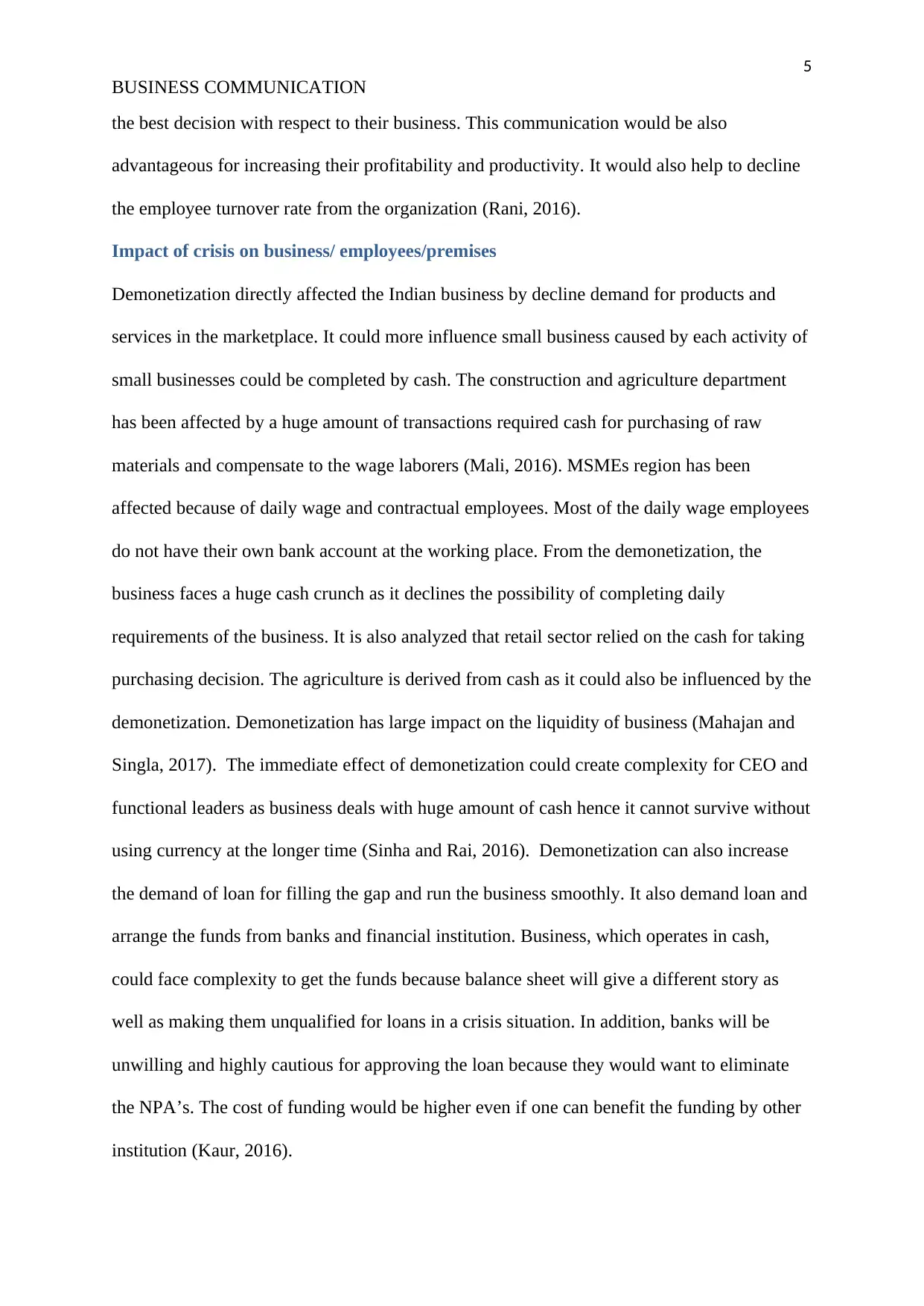
5
BUSINESS COMMUNICATION
the best decision with respect to their business. This communication would be also
advantageous for increasing their profitability and productivity. It would also help to decline
the employee turnover rate from the organization (Rani, 2016).
Impact of crisis on business/ employees/premises
Demonetization directly affected the Indian business by decline demand for products and
services in the marketplace. It could more influence small business caused by each activity of
small businesses could be completed by cash. The construction and agriculture department
has been affected by a huge amount of transactions required cash for purchasing of raw
materials and compensate to the wage laborers (Mali, 2016). MSMEs region has been
affected because of daily wage and contractual employees. Most of the daily wage employees
do not have their own bank account at the working place. From the demonetization, the
business faces a huge cash crunch as it declines the possibility of completing daily
requirements of the business. It is also analyzed that retail sector relied on the cash for taking
purchasing decision. The agriculture is derived from cash as it could also be influenced by the
demonetization. Demonetization has large impact on the liquidity of business (Mahajan and
Singla, 2017). The immediate effect of demonetization could create complexity for CEO and
functional leaders as business deals with huge amount of cash hence it cannot survive without
using currency at the longer time (Sinha and Rai, 2016). Demonetization can also increase
the demand of loan for filling the gap and run the business smoothly. It also demand loan and
arrange the funds from banks and financial institution. Business, which operates in cash,
could face complexity to get the funds because balance sheet will give a different story as
well as making them unqualified for loans in a crisis situation. In addition, banks will be
unwilling and highly cautious for approving the loan because they would want to eliminate
the NPA’s. The cost of funding would be higher even if one can benefit the funding by other
institution (Kaur, 2016).
BUSINESS COMMUNICATION
the best decision with respect to their business. This communication would be also
advantageous for increasing their profitability and productivity. It would also help to decline
the employee turnover rate from the organization (Rani, 2016).
Impact of crisis on business/ employees/premises
Demonetization directly affected the Indian business by decline demand for products and
services in the marketplace. It could more influence small business caused by each activity of
small businesses could be completed by cash. The construction and agriculture department
has been affected by a huge amount of transactions required cash for purchasing of raw
materials and compensate to the wage laborers (Mali, 2016). MSMEs region has been
affected because of daily wage and contractual employees. Most of the daily wage employees
do not have their own bank account at the working place. From the demonetization, the
business faces a huge cash crunch as it declines the possibility of completing daily
requirements of the business. It is also analyzed that retail sector relied on the cash for taking
purchasing decision. The agriculture is derived from cash as it could also be influenced by the
demonetization. Demonetization has large impact on the liquidity of business (Mahajan and
Singla, 2017). The immediate effect of demonetization could create complexity for CEO and
functional leaders as business deals with huge amount of cash hence it cannot survive without
using currency at the longer time (Sinha and Rai, 2016). Demonetization can also increase
the demand of loan for filling the gap and run the business smoothly. It also demand loan and
arrange the funds from banks and financial institution. Business, which operates in cash,
could face complexity to get the funds because balance sheet will give a different story as
well as making them unqualified for loans in a crisis situation. In addition, banks will be
unwilling and highly cautious for approving the loan because they would want to eliminate
the NPA’s. The cost of funding would be higher even if one can benefit the funding by other
institution (Kaur, 2016).
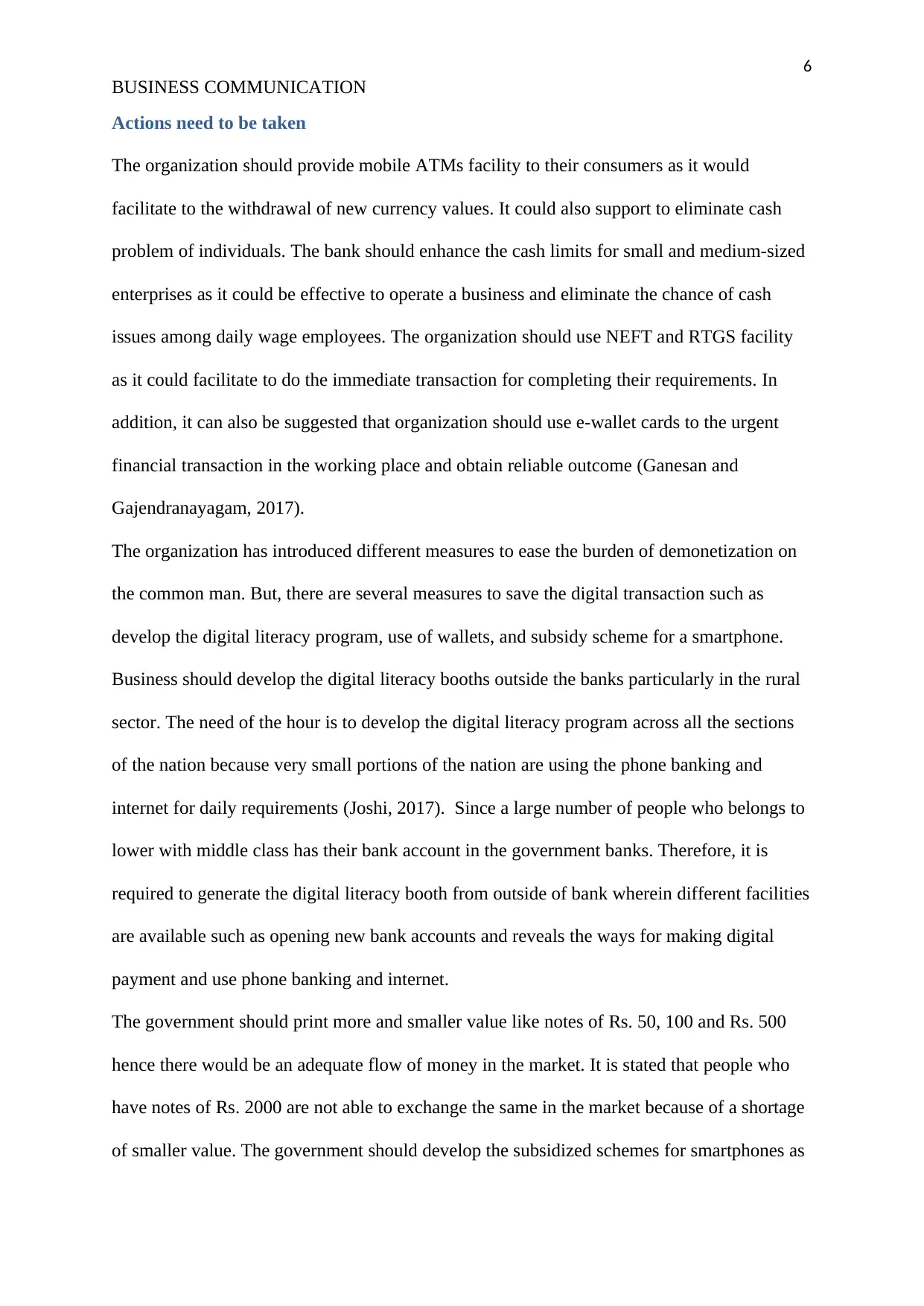
6
BUSINESS COMMUNICATION
Actions need to be taken
The organization should provide mobile ATMs facility to their consumers as it would
facilitate to the withdrawal of new currency values. It could also support to eliminate cash
problem of individuals. The bank should enhance the cash limits for small and medium-sized
enterprises as it could be effective to operate a business and eliminate the chance of cash
issues among daily wage employees. The organization should use NEFT and RTGS facility
as it could facilitate to do the immediate transaction for completing their requirements. In
addition, it can also be suggested that organization should use e-wallet cards to the urgent
financial transaction in the working place and obtain reliable outcome (Ganesan and
Gajendranayagam, 2017).
The organization has introduced different measures to ease the burden of demonetization on
the common man. But, there are several measures to save the digital transaction such as
develop the digital literacy program, use of wallets, and subsidy scheme for a smartphone.
Business should develop the digital literacy booths outside the banks particularly in the rural
sector. The need of the hour is to develop the digital literacy program across all the sections
of the nation because very small portions of the nation are using the phone banking and
internet for daily requirements (Joshi, 2017). Since a large number of people who belongs to
lower with middle class has their bank account in the government banks. Therefore, it is
required to generate the digital literacy booth from outside of bank wherein different facilities
are available such as opening new bank accounts and reveals the ways for making digital
payment and use phone banking and internet.
The government should print more and smaller value like notes of Rs. 50, 100 and Rs. 500
hence there would be an adequate flow of money in the market. It is stated that people who
have notes of Rs. 2000 are not able to exchange the same in the market because of a shortage
of smaller value. The government should develop the subsidized schemes for smartphones as
BUSINESS COMMUNICATION
Actions need to be taken
The organization should provide mobile ATMs facility to their consumers as it would
facilitate to the withdrawal of new currency values. It could also support to eliminate cash
problem of individuals. The bank should enhance the cash limits for small and medium-sized
enterprises as it could be effective to operate a business and eliminate the chance of cash
issues among daily wage employees. The organization should use NEFT and RTGS facility
as it could facilitate to do the immediate transaction for completing their requirements. In
addition, it can also be suggested that organization should use e-wallet cards to the urgent
financial transaction in the working place and obtain reliable outcome (Ganesan and
Gajendranayagam, 2017).
The organization has introduced different measures to ease the burden of demonetization on
the common man. But, there are several measures to save the digital transaction such as
develop the digital literacy program, use of wallets, and subsidy scheme for a smartphone.
Business should develop the digital literacy booths outside the banks particularly in the rural
sector. The need of the hour is to develop the digital literacy program across all the sections
of the nation because very small portions of the nation are using the phone banking and
internet for daily requirements (Joshi, 2017). Since a large number of people who belongs to
lower with middle class has their bank account in the government banks. Therefore, it is
required to generate the digital literacy booth from outside of bank wherein different facilities
are available such as opening new bank accounts and reveals the ways for making digital
payment and use phone banking and internet.
The government should print more and smaller value like notes of Rs. 50, 100 and Rs. 500
hence there would be an adequate flow of money in the market. It is stated that people who
have notes of Rs. 2000 are not able to exchange the same in the market because of a shortage
of smaller value. The government should develop the subsidized schemes for smartphones as
⊘ This is a preview!⊘
Do you want full access?
Subscribe today to unlock all pages.

Trusted by 1+ million students worldwide
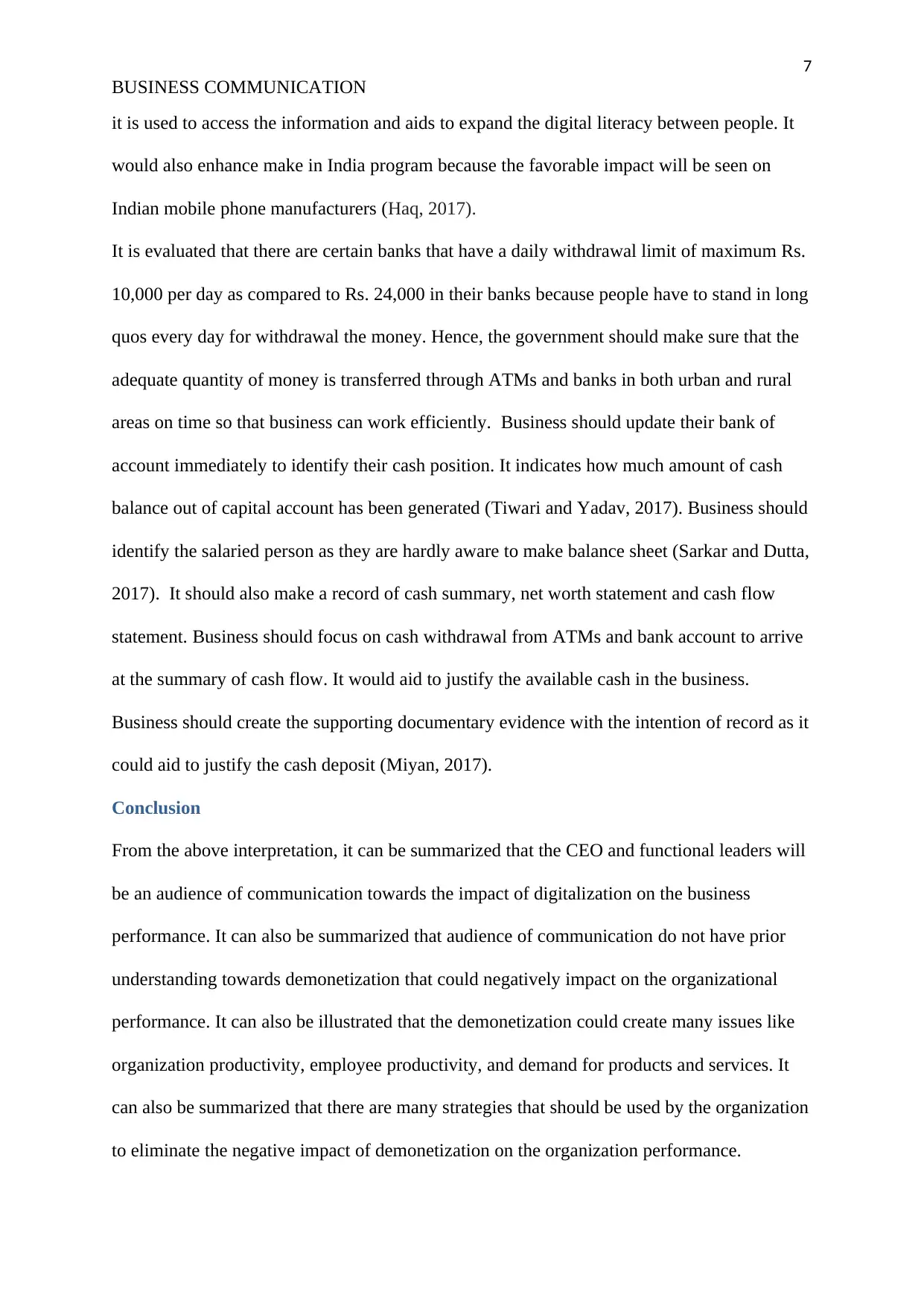
7
BUSINESS COMMUNICATION
it is used to access the information and aids to expand the digital literacy between people. It
would also enhance make in India program because the favorable impact will be seen on
Indian mobile phone manufacturers (Haq, 2017).
It is evaluated that there are certain banks that have a daily withdrawal limit of maximum Rs.
10,000 per day as compared to Rs. 24,000 in their banks because people have to stand in long
quos every day for withdrawal the money. Hence, the government should make sure that the
adequate quantity of money is transferred through ATMs and banks in both urban and rural
areas on time so that business can work efficiently. Business should update their bank of
account immediately to identify their cash position. It indicates how much amount of cash
balance out of capital account has been generated (Tiwari and Yadav, 2017). Business should
identify the salaried person as they are hardly aware to make balance sheet (Sarkar and Dutta,
2017). It should also make a record of cash summary, net worth statement and cash flow
statement. Business should focus on cash withdrawal from ATMs and bank account to arrive
at the summary of cash flow. It would aid to justify the available cash in the business.
Business should create the supporting documentary evidence with the intention of record as it
could aid to justify the cash deposit (Miyan, 2017).
Conclusion
From the above interpretation, it can be summarized that the CEO and functional leaders will
be an audience of communication towards the impact of digitalization on the business
performance. It can also be summarized that audience of communication do not have prior
understanding towards demonetization that could negatively impact on the organizational
performance. It can also be illustrated that the demonetization could create many issues like
organization productivity, employee productivity, and demand for products and services. It
can also be summarized that there are many strategies that should be used by the organization
to eliminate the negative impact of demonetization on the organization performance.
BUSINESS COMMUNICATION
it is used to access the information and aids to expand the digital literacy between people. It
would also enhance make in India program because the favorable impact will be seen on
Indian mobile phone manufacturers (Haq, 2017).
It is evaluated that there are certain banks that have a daily withdrawal limit of maximum Rs.
10,000 per day as compared to Rs. 24,000 in their banks because people have to stand in long
quos every day for withdrawal the money. Hence, the government should make sure that the
adequate quantity of money is transferred through ATMs and banks in both urban and rural
areas on time so that business can work efficiently. Business should update their bank of
account immediately to identify their cash position. It indicates how much amount of cash
balance out of capital account has been generated (Tiwari and Yadav, 2017). Business should
identify the salaried person as they are hardly aware to make balance sheet (Sarkar and Dutta,
2017). It should also make a record of cash summary, net worth statement and cash flow
statement. Business should focus on cash withdrawal from ATMs and bank account to arrive
at the summary of cash flow. It would aid to justify the available cash in the business.
Business should create the supporting documentary evidence with the intention of record as it
could aid to justify the cash deposit (Miyan, 2017).
Conclusion
From the above interpretation, it can be summarized that the CEO and functional leaders will
be an audience of communication towards the impact of digitalization on the business
performance. It can also be summarized that audience of communication do not have prior
understanding towards demonetization that could negatively impact on the organizational
performance. It can also be illustrated that the demonetization could create many issues like
organization productivity, employee productivity, and demand for products and services. It
can also be summarized that there are many strategies that should be used by the organization
to eliminate the negative impact of demonetization on the organization performance.
Paraphrase This Document
Need a fresh take? Get an instant paraphrase of this document with our AI Paraphraser
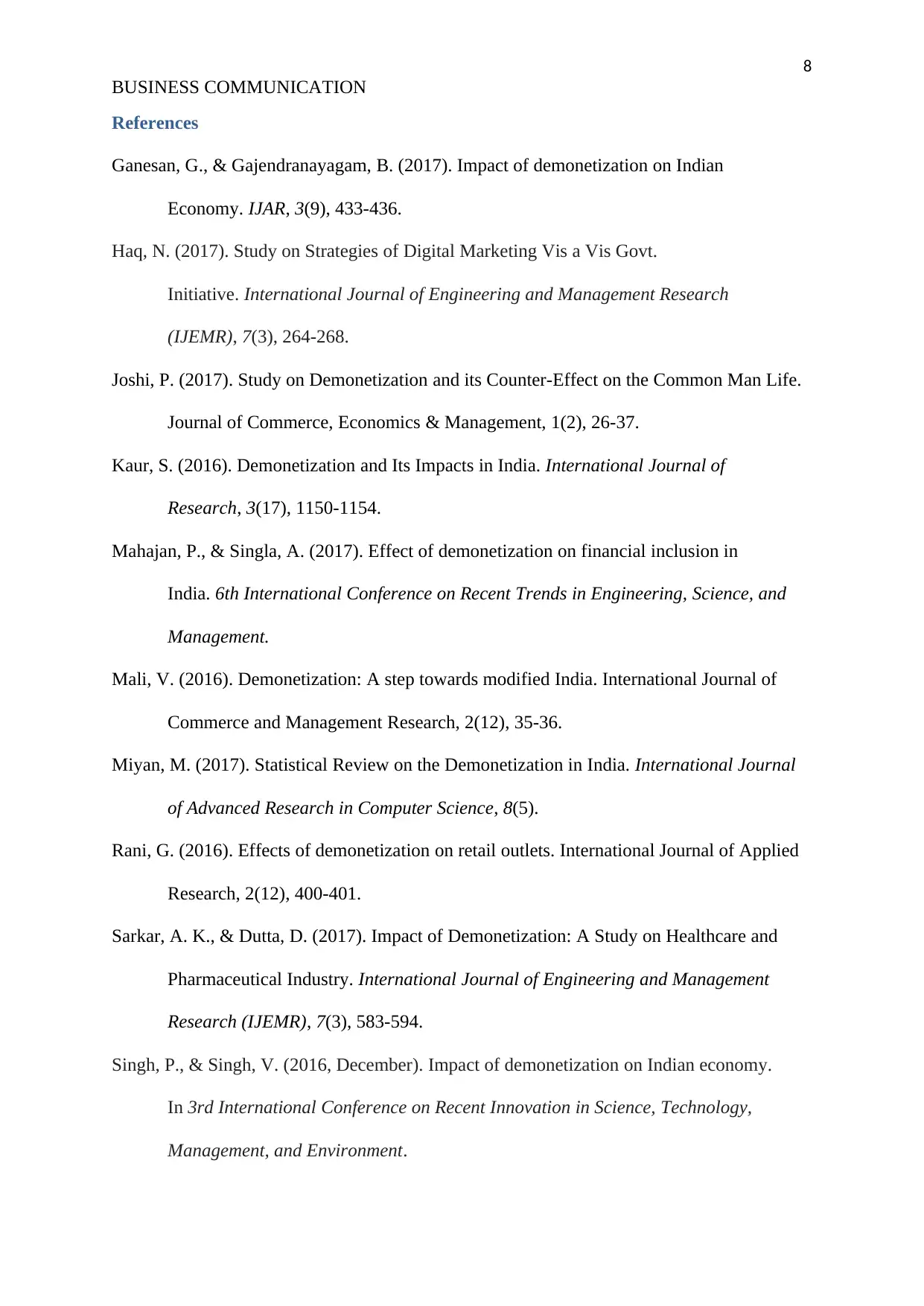
8
BUSINESS COMMUNICATION
References
Ganesan, G., & Gajendranayagam, B. (2017). Impact of demonetization on Indian
Economy. IJAR, 3(9), 433-436.
Haq, N. (2017). Study on Strategies of Digital Marketing Vis a Vis Govt.
Initiative. International Journal of Engineering and Management Research
(IJEMR), 7(3), 264-268.
Joshi, P. (2017). Study on Demonetization and its Counter-Effect on the Common Man Life.
Journal of Commerce, Economics & Management, 1(2), 26-37.
Kaur, S. (2016). Demonetization and Its Impacts in India. International Journal of
Research, 3(17), 1150-1154.
Mahajan, P., & Singla, A. (2017). Effect of demonetization on financial inclusion in
India. 6th International Conference on Recent Trends in Engineering, Science, and
Management.
Mali, V. (2016). Demonetization: A step towards modified India. International Journal of
Commerce and Management Research, 2(12), 35-36.
Miyan, M. (2017). Statistical Review on the Demonetization in India. International Journal
of Advanced Research in Computer Science, 8(5).
Rani, G. (2016). Effects of demonetization on retail outlets. International Journal of Applied
Research, 2(12), 400-401.
Sarkar, A. K., & Dutta, D. (2017). Impact of Demonetization: A Study on Healthcare and
Pharmaceutical Industry. International Journal of Engineering and Management
Research (IJEMR), 7(3), 583-594.
Singh, P., & Singh, V. (2016, December). Impact of demonetization on Indian economy.
In 3rd International Conference on Recent Innovation in Science, Technology,
Management, and Environment.
BUSINESS COMMUNICATION
References
Ganesan, G., & Gajendranayagam, B. (2017). Impact of demonetization on Indian
Economy. IJAR, 3(9), 433-436.
Haq, N. (2017). Study on Strategies of Digital Marketing Vis a Vis Govt.
Initiative. International Journal of Engineering and Management Research
(IJEMR), 7(3), 264-268.
Joshi, P. (2017). Study on Demonetization and its Counter-Effect on the Common Man Life.
Journal of Commerce, Economics & Management, 1(2), 26-37.
Kaur, S. (2016). Demonetization and Its Impacts in India. International Journal of
Research, 3(17), 1150-1154.
Mahajan, P., & Singla, A. (2017). Effect of demonetization on financial inclusion in
India. 6th International Conference on Recent Trends in Engineering, Science, and
Management.
Mali, V. (2016). Demonetization: A step towards modified India. International Journal of
Commerce and Management Research, 2(12), 35-36.
Miyan, M. (2017). Statistical Review on the Demonetization in India. International Journal
of Advanced Research in Computer Science, 8(5).
Rani, G. (2016). Effects of demonetization on retail outlets. International Journal of Applied
Research, 2(12), 400-401.
Sarkar, A. K., & Dutta, D. (2017). Impact of Demonetization: A Study on Healthcare and
Pharmaceutical Industry. International Journal of Engineering and Management
Research (IJEMR), 7(3), 583-594.
Singh, P., & Singh, V. (2016, December). Impact of demonetization on Indian economy.
In 3rd International Conference on Recent Innovation in Science, Technology,
Management, and Environment.
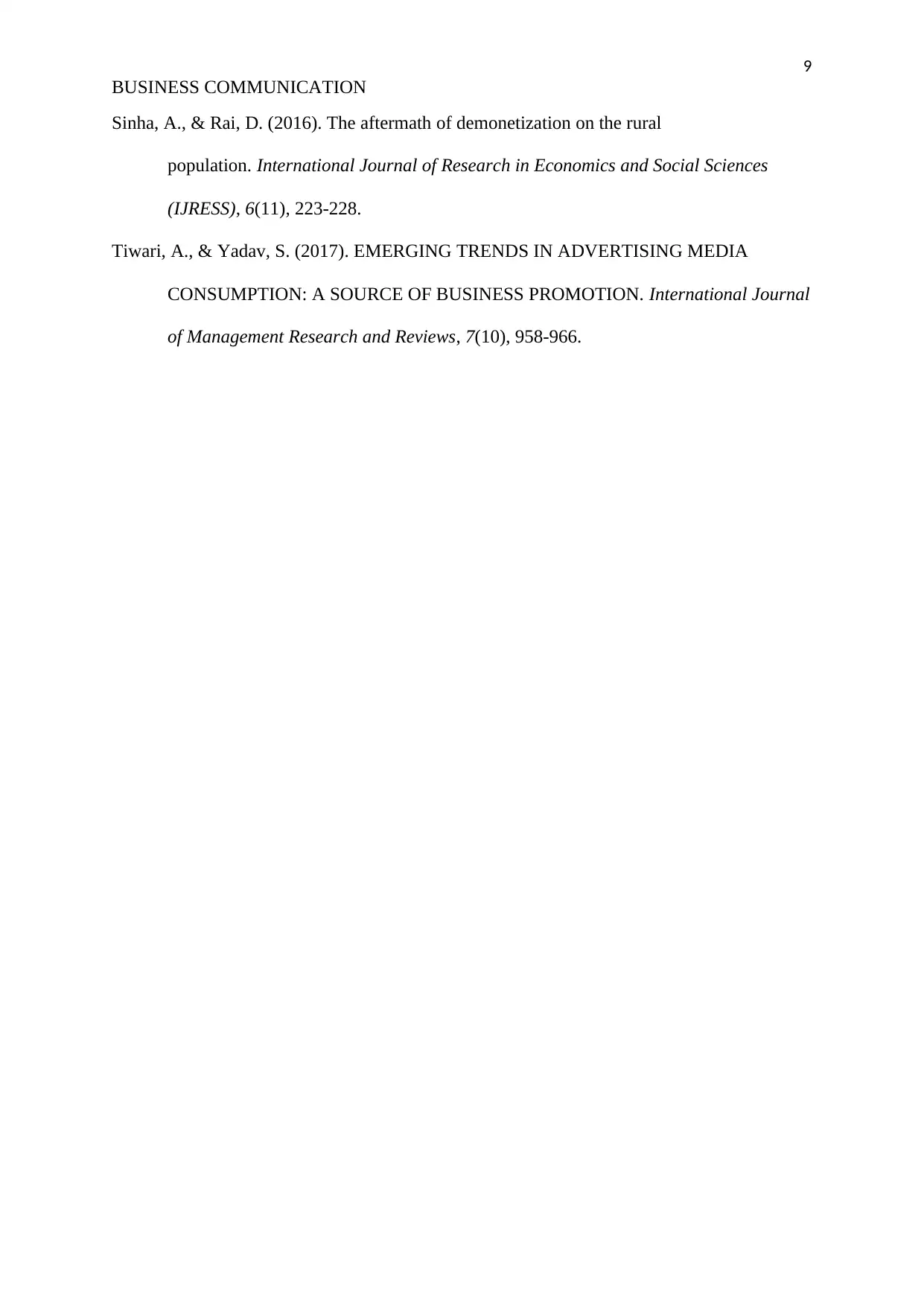
9
BUSINESS COMMUNICATION
Sinha, A., & Rai, D. (2016). The aftermath of demonetization on the rural
population. International Journal of Research in Economics and Social Sciences
(IJRESS), 6(11), 223-228.
Tiwari, A., & Yadav, S. (2017). EMERGING TRENDS IN ADVERTISING MEDIA
CONSUMPTION: A SOURCE OF BUSINESS PROMOTION. International Journal
of Management Research and Reviews, 7(10), 958-966.
BUSINESS COMMUNICATION
Sinha, A., & Rai, D. (2016). The aftermath of demonetization on the rural
population. International Journal of Research in Economics and Social Sciences
(IJRESS), 6(11), 223-228.
Tiwari, A., & Yadav, S. (2017). EMERGING TRENDS IN ADVERTISING MEDIA
CONSUMPTION: A SOURCE OF BUSINESS PROMOTION. International Journal
of Management Research and Reviews, 7(10), 958-966.
⊘ This is a preview!⊘
Do you want full access?
Subscribe today to unlock all pages.

Trusted by 1+ million students worldwide
1 out of 9
Related Documents
Your All-in-One AI-Powered Toolkit for Academic Success.
+13062052269
info@desklib.com
Available 24*7 on WhatsApp / Email
![[object Object]](/_next/static/media/star-bottom.7253800d.svg)
Unlock your academic potential
Copyright © 2020–2025 A2Z Services. All Rights Reserved. Developed and managed by ZUCOL.



